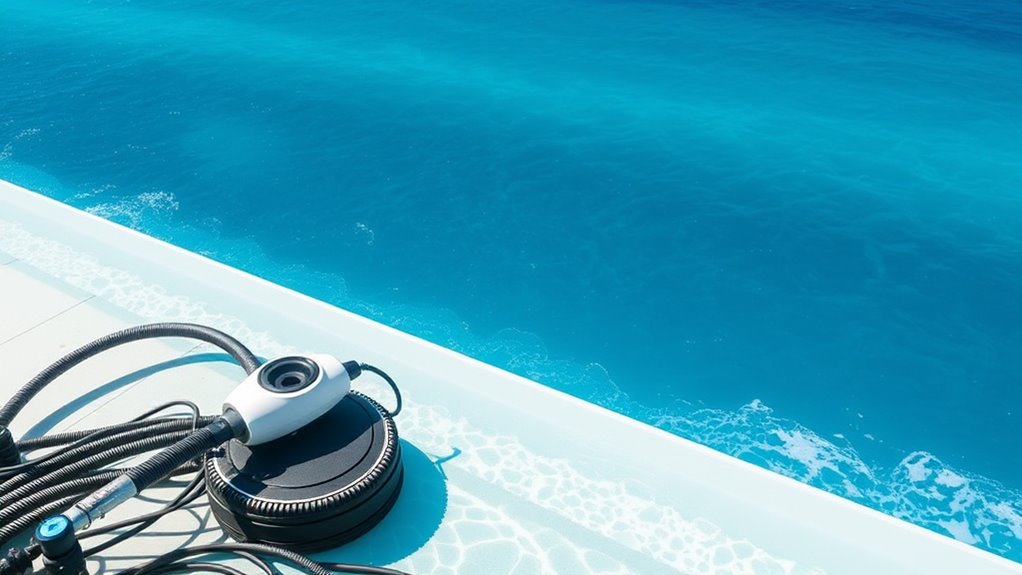Maintaining a seaside infinity pool is challenging due to saltwater corrosion, weather damage, and debris buildup. Salt accelerates rust on metal parts and damages surfaces, while wind, rain, and storms wear down the structure. You need to monitor water quality, clean regularly, and inspect for cracks or leaks. Proper maintenance extends the lifespan of your pool, and there’s more to discover on how to keep it in pristine condition over time.
Key Takeaways
- Saltwater causes corrosion of metal fixtures, pumps, and liners, requiring resistant materials and regular inspections.
- Weather exposure from wind, UV rays, and storms accelerates surface damage and structural deterioration.
- Frequent water testing and treatment are essential to maintain clarity and prevent algae growth.
- Structural components need regular inspection for cracks and waterproofing to ensure longevity in harsh seaside conditions.
- Daily debris removal and proper filtration are vital to preserve water quality and pool aesthetics.
The Impact of Saltwater and Corrosion
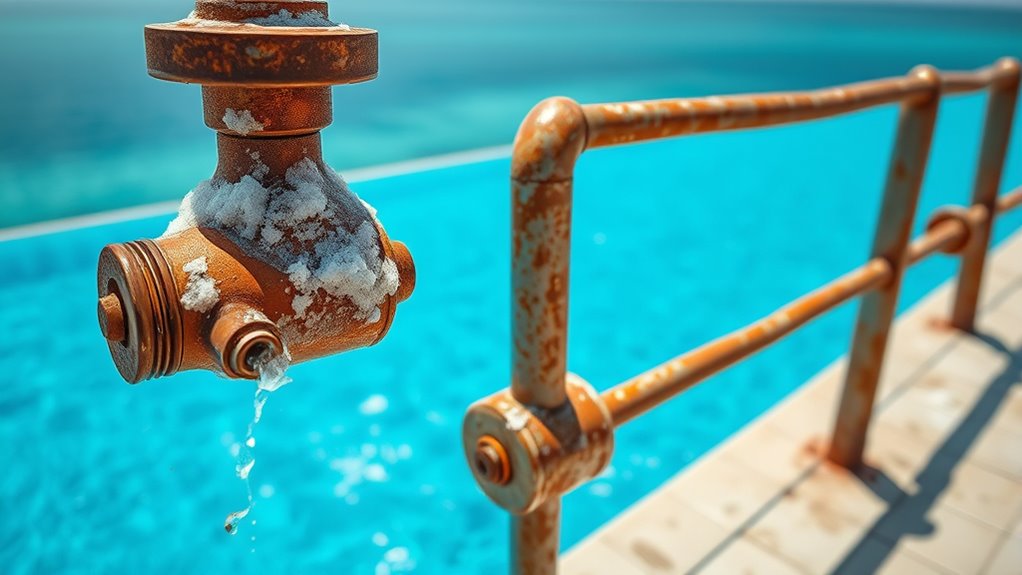
Saltwater is highly corrosive, and when it comes into contact with the materials used in your seaside infinity pool, it can cause significant damage over time. Metal components like handrails, fixtures, and pumps are especially vulnerable, as salt accelerates rust and corrosion. Even concrete surfaces can deteriorate if not properly sealed, leading to cracks and surface erosion. The salt can also damage pool liners and plumbing, reducing their lifespan and increasing repair costs. To protect your investment, you need to regularly inspect for corrosion signs and use corrosion-resistant materials such as stainless steel or specialized coatings. Maintaining proper water chemistry by balancing pH levels also helps minimize salt’s corrosive effects, ensuring your pool remains pristine and functional for years to come. Additionally, understanding corrosion prevention techniques can help prolong the lifespan of your pool components and reduce maintenance costs.
Weather-Related Wear and Tear
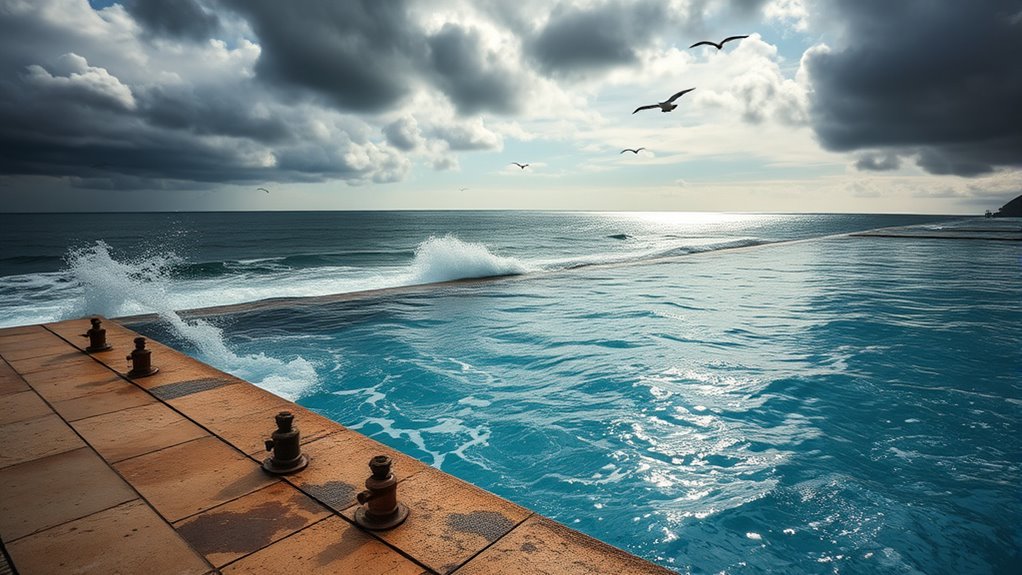
Weather conditions can considerably accelerate wear and tear on your seaside infinity pool. Strong winds can carry salty air and debris, leading to corrosion of metal components and surface damage. UV rays from the sun cause fading and weaken pool finishes over time. Heavy rain can lead to rapid erosion of the surrounding deck and foundation if not properly managed. Temperature fluctuations cause expansion and contraction of materials, increasing the risk of cracks and leaks. High humidity promotes mold growth and promotes corrosion of pool equipment. Storms and high tides can cause physical damage to the structure or introduce debris that clogs filtration systems. Additionally, AI security measures can assist in monitoring structural integrity through smart sensors and predictive analytics. Regular inspections and protective measures, such as covers and corrosion-resistant materials, are essential to mitigate weather-related deterioration and prolong your pool’s lifespan.
Maintaining Water Quality and Clarity
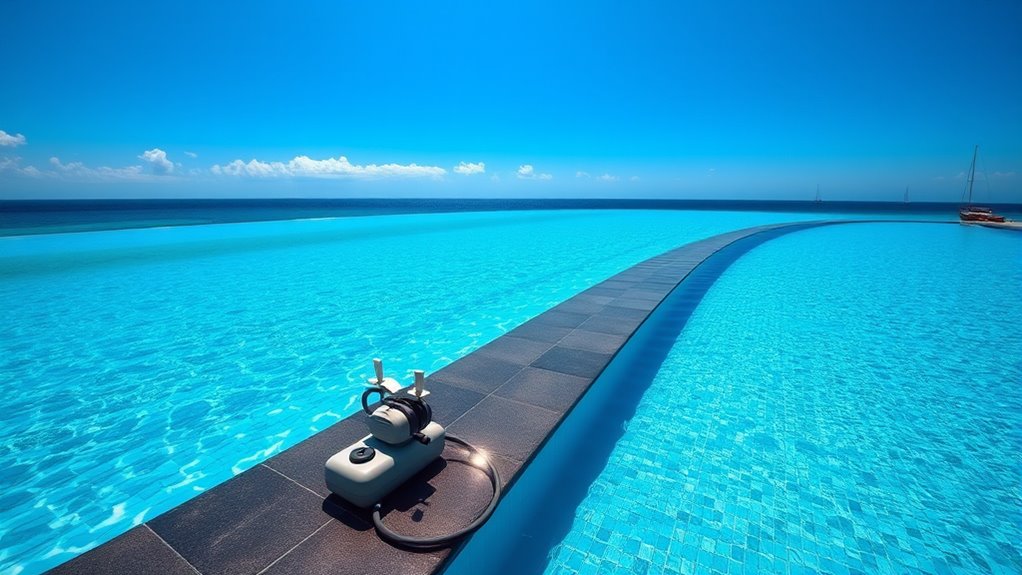
Keeping the water in your seaside infinity pool clean and clear requires regular attention and proper chemical balance. You’ll need to monitor pH levels, chlorine, and alkalinity frequently to prevent algae growth and cloudy water. Use tested water treatments to keep everything balanced, especially after heavy rainfall or high usage. Maintaining optimal water quality is essential for ensuring the longevity and safety of your pool environment.
Here’s a quick guide:
| Action | Purpose |
|---|---|
| Test water daily | Detect imbalances early |
| Add chlorine regularly | Kill bacteria and algae |
| Skim debris weekly | Remove leaves and dirt |
Staying on top of these tasks ensures your pool remains inviting and safe, even with the seaside environment’s challenges. Consistent maintenance keeps your infinity view stunning and your water sparkling.
Structural Integrity and Waterproofing Challenges
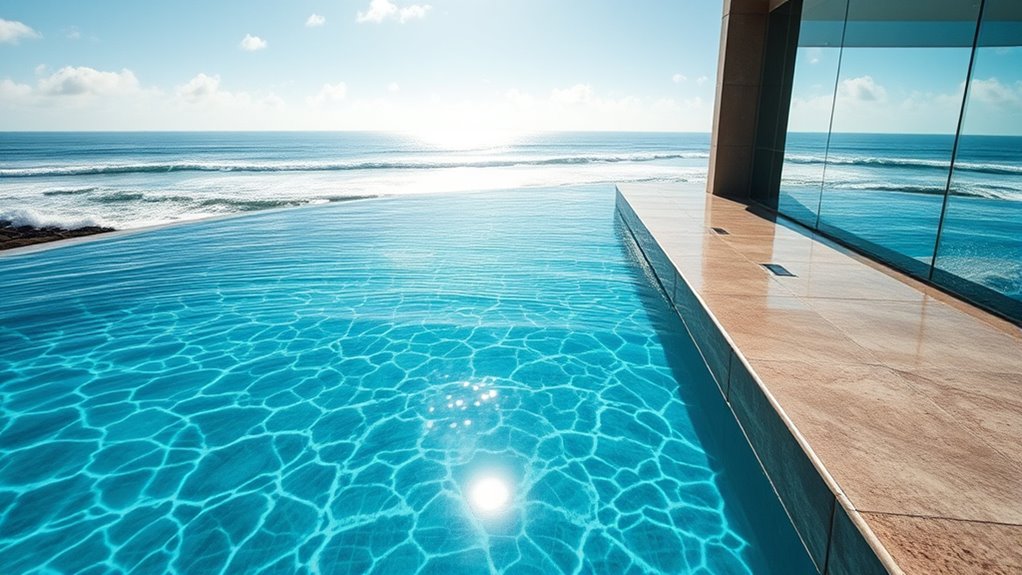
Maintaining water quality is essential, but addressing the structural integrity and waterproofing of your seaside infinity pool is equally important to guarantee longevity and safety. Saltwater exposure and harsh weather conditions can weaken the pool’s structure over time. To prevent issues, you need to:
- Regularly inspect for cracks or signs of deterioration in the concrete and joints
- Ensure waterproof membranes are intact and properly sealed
- Monitor for corrosion in metal components and apply protective coatings as needed
- Incorporating proper maintenance practices can significantly extend the lifespan of your pool and prevent costly repairs.
Failing to uphold these elements can lead to leaks, structural failures, or costly repairs. Pay close attention to the pool’s foundation and surrounding walls, especially in exposed seaside environments. Proper upkeep protects your investment and keeps your infinity pool safe and functional for years to come.
Regular Cleaning and Debris Management
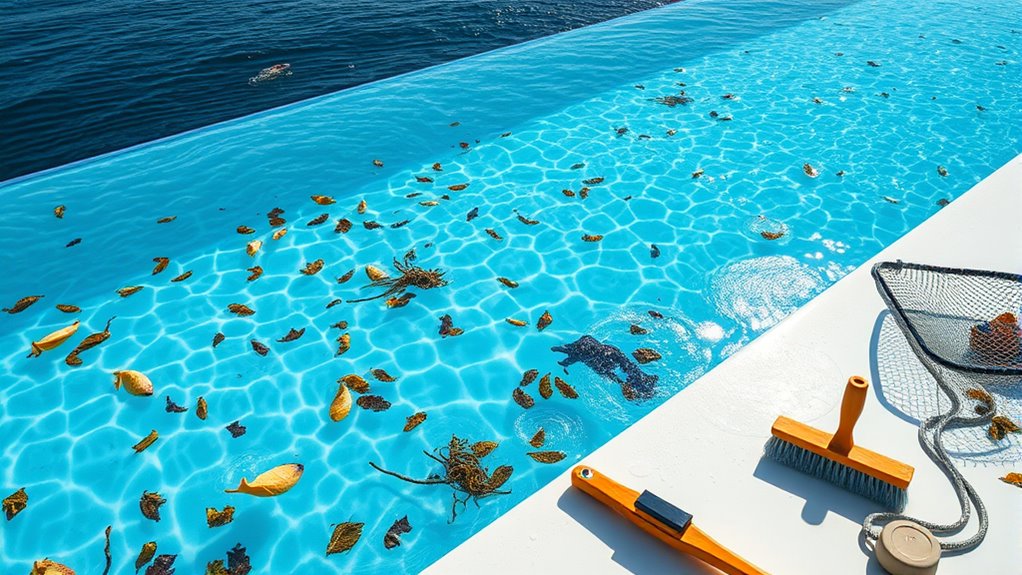
To keep your seaside infinity pool looking pristine and functioning smoothly, regular cleaning and debris management are essential. Wind and waves often carry leaves, dirt, and other debris into the water, which can affect water quality and clarity. You should skim the surface daily to remove floating debris and prevent clogging of filters. Regularly vacuum the pool floor to eliminate settled dirt and debris. Check and clean the skimmers and filters to ensure proper circulation. Keep an eye on the water chemistry, balancing pH and chlorine levels to prevent algae growth and maintain water safety. Additionally, understanding the contrast ratio of your pool’s lighting and surroundings can help optimize visibility and aesthetic appeal during evening hours. Consistent maintenance not only preserves the pool’s appearance but also extends its lifespan, ensuring you enjoy clear, inviting water with minimal disruptions.
Frequently Asked Questions
How Often Should the Pool’s Salt Levels Be Tested?
You should test your pool’s salt levels at least once a week to guarantee proper chemical balance. During hot or heavy use periods, increase testing to every few days. Use a reliable salt test kit, and adjust the salt level as needed to stay within the recommended range specified by your pool manufacturer. Regular testing helps prevent corrosion, cloudy water, and other issues, keeping your infinity pool pristine.
What Are the Best Materials for Pool Waterproofing?
You should use high-quality waterproofing materials like epoxy coatings, polyurethane membranes, or bentonite clay for your pool. These materials provide excellent flexibility, durability, and resistance to water pressure, especially in seaside environments. Apply them carefully following manufacturer instructions to guarantee a seamless, watertight seal. Regular inspections and maintenance help identify any potential issues early, prolonging the lifespan of your pool and keeping it properly sealed against moisture and saltwater intrusion.
How Can Algae Growth Be Prevented in Seaside Pools?
To prevent algae growth in seaside pools, you should regularly maintain proper water chemistry by balancing pH and sanitizer levels. Use a robust chlorine or bromine system, and consider adding algaecides as a preventive measure. Clean the pool frequently to remove debris and algae spores, and make certain of good circulation. Cover the pool when not in use, especially during off-seasons, to reduce exposure to algae spores carried by wind or rain.
What Are Signs of Structural Damage in an Infinity Pool?
You should look for cracks or chips along the pool’s edges and surface, as these indicate structural damage. Watch for uneven water levels or persistent leaks, which suggest internal issues. If the pool’s tilework or coping becomes loose or dislodged, that’s a clear sign. Also, notice any shifting or sagging of the pool structure, as these signs point to underlying damage that needs prompt attention to prevent further deterioration.
Which Cleaning Tools Are Most Effective for Large Seaside Pools?
For large seaside pools, heavy-duty telescopic brushes and pool vacuums are your best tools. You might think they’re costly, but they save you time and effort in the long run. Use a high-quality skimmer net to remove debris from the surface daily. Consider robotic cleaners for consistent, thorough cleaning without manual labor. These tools ensure your pool stays pristine despite the harsh seaside environment.
Conclusion
Think of your seaside infinity pool as a delicate ship sailing the unpredictable ocean. With saltwater and weather as your relentless storms, your maintenance efforts are the steady crew keeping everything afloat. Regular care and vigilance make certain your paradise remains pristine and resilient against nature’s challenges. With each thoughtful action, you’re the captain safeguarding this breathtaking vista—turning a fleeting illusion into a lasting sanctuary where beauty endures against all odds.
